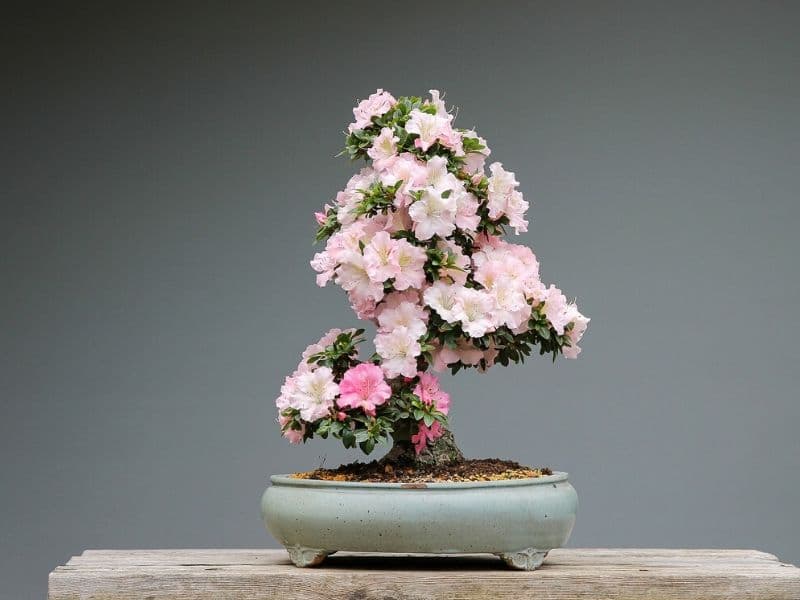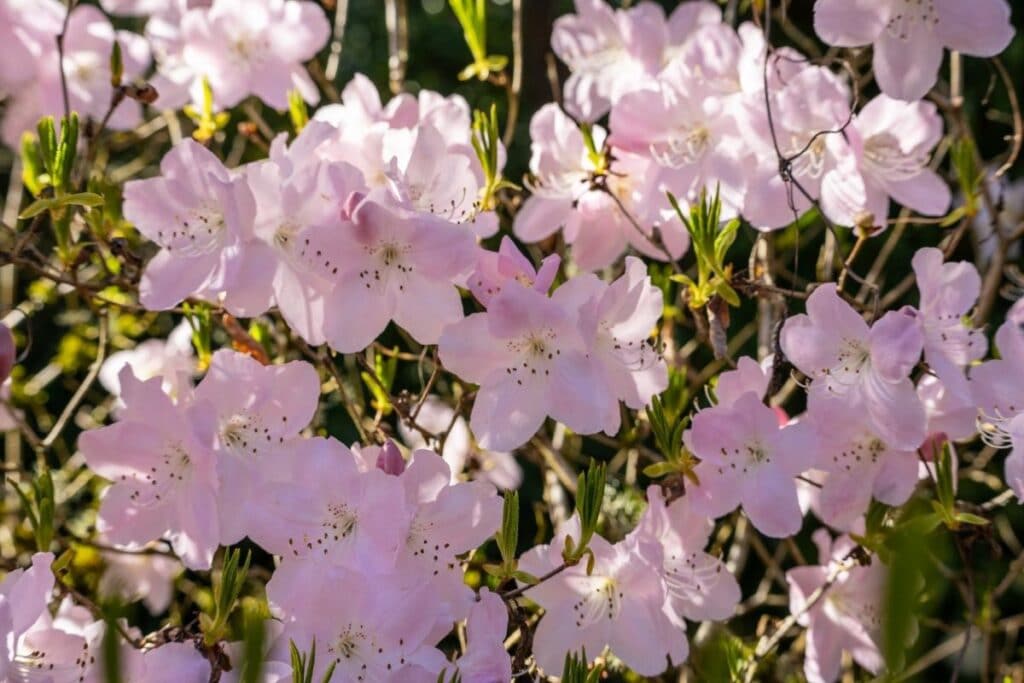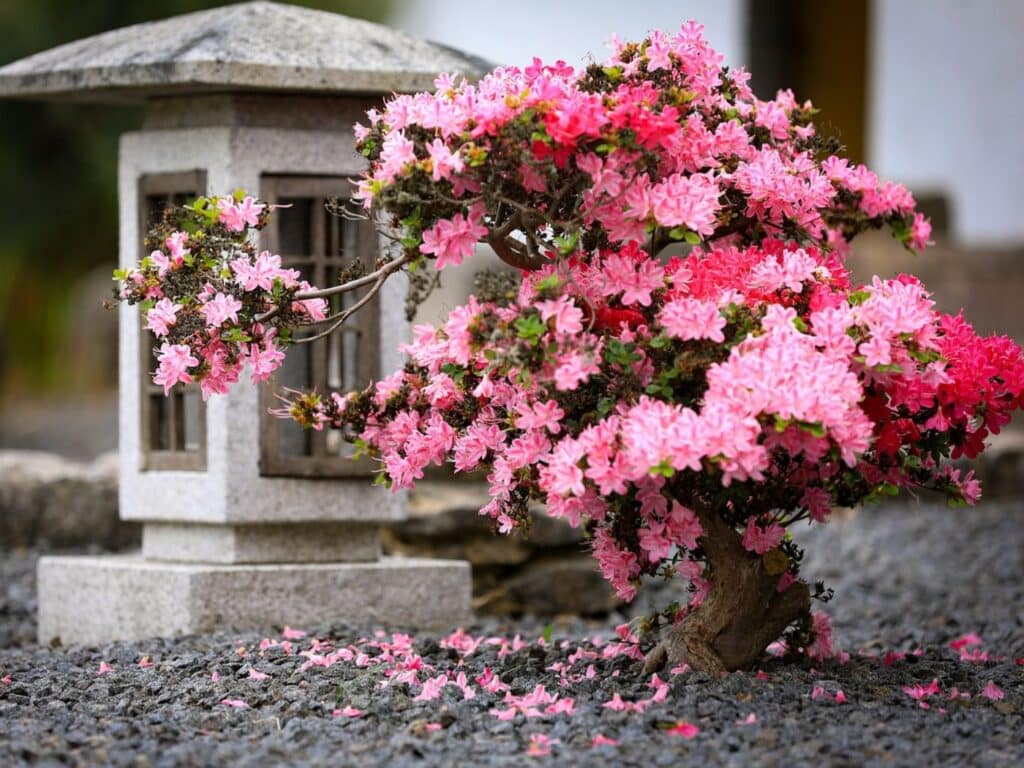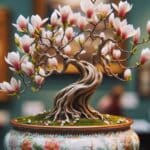Azalea bonsai trees (Rhododendron) are likely some of the most beautiful flowering bonsai species. This delicate evergreen tree is most impressive during spring (although some bloom more than once a year) when they mass produce striking flowers like white, pink, yellowish, or dark purple.
This charming flowering plant is a favorite amongst bonsai keepers because it symbolizes love, passion, good luck, fragility, and strength.
You will see only a few Satsuki bonsai trees in average households because they can be challenging to care for. Growing your own satsuki azalea bonsai tree can, however, be a very rewarding experience.
If you want to grow this type of miniature flowering bonsai or acquire one and take good care of it, then pay close attention to the tips we will share.

Plant Facts
| Scientific name | Rhododendron |
| Common names | Satsuki azalea, kurume azalea, azalea bonsai tree |
| Family | Ericaceae |
| Plant Type | Houseplant |
| Height and Width | 3 – 4 ft. tall (natural), 2–3 ft. tall (bonsai) |
| Origin | Japan, China, Korea, or Taiwan |
| Flower colors | White, yellowish, pink, orange, red, dark purple |
| Foliage color | Dark green |
| Sun Exposure | Partial shade with morning or evening sun |
| Soil Type & pH | Lime-free soil that is slightly acidic and well-draining |
| Special features | Evergreen flowering tree, good for containers |
What Does an Azalea Bonsai Tree Look Like
In their natural form, rhododendrons are flowering shrubs. There are many different varieties of these flowering plants. Still, the Satsuki azalea (rhododendron indicum) is one of the most popular for bonsai creations because the leaf growth on this dwarf variety is a lot smaller, and it produces individual blooms.
Satsuki bonsai trees are evergreen with fine branches and a small leaf pattern. They have a ramified branch structure and can be styled into various bonsai shapes, such as informal upright, slanting, windswept, semi-cascade, or rock-over-root shapes.
Where Do Bonsai Azaleas Grow
The Satsuki azalea plant originates from Southern Japan. This plant grows wild in the Mountains of Japan, and it prefers cooler climates with semi-shade.
Azalea bonsai trees are usually kept outside because they need lots of direct sunlight and good ventilation to bloom. They can be brought indoors during the cold winters because the plants are not cold hardy. These plants should also be protected from direct sunlight during the hottest part of the day, or their flowers and leaves will become scorched.
How to Grow an Azalea Bonsai Tree
Azalea bonsai isn’t the easiest of bonsai species to grow or care for. They require a lot of maintenance and training, and pruning your little tree can be challenging. Here are some tips to help you establish and train azalea bonsai plants.
Propagation
Azaleas can be grown from seed but the seed pods do have a low germination rate. Azalea Satsuki is also a hybrid plant. When you grow it from seed, it can look like either parent plants or it can be a mixture of the two. Growing from cuttings is usually a much more reliable option. Let’s take a closer look at how to grow this member of the rhododendron family.
Propagation from cuttings
It is best to take semi-ripe cuttings to propagate an azalea bonsai from cuttings during mid to late summer. The cuttings should be about 5 inches long and should be cut at a 45-degree angle. Remove all leaves from the bottom part of the cutting, but leave a few fresh leaves at the top.
Before you plant the cutting, it should be sterilized. To do this, you can soak it in a 1:10 solution of bleach and water.
Dip the cutting stem in some rooting hormone to encourage root development.
Plant the cutting in a well-drained rooting medium or a soil mixture with equal parts of peat and perlite. Keep the soil moist until the cutting takes.
It is usually best to create a greenhouse effect or your cutting so the plant won’t dry out. To do this, place a plastic container (the top of a clear plastic drink bottle is best) over the cutting.
Keep your plant in a warm area with bright indirect light until you see it sprout new shoots.
Soil
Azalea bonsai trees cannot be planted in just any potting soil or even any ordinary bonsai soil mixture. Your soil should be lime-free soil.
Azalea bonsai trees are usually grown in a soil called Kanuma; a soft acidic, volcanic soil.
You can also create your own soil mix by combining peat moss, perlite, and pine bark.
Pruning and Training
Satsuki azaleas are slow-growing evergreens that require a strong pruning routine in order to keep them healthy and maintain a desired shape.
If your sapling or cutting is large and strong enough to handle pruning and training, you can start transforming it into a bonsai.

Training Your Bonsai Trees
The first step is usually to identify a desirable shape for your tree. Consider your plant’s natural structure and choose a bonsai tree shape that can accommodate this structure. Here are the most common shapes for azalea bonsai trees:
- Semi-cascade
- Windswept
- Slanting
- Informal Upright
You can then proceed to clip off any unwanted shoots or branches that don’t fit in with your desired shape. Remove ingrown shoots and any stems or leaves that are damaged or diseased.
Wiring the Azalea
Wiring your bonsai should be done before the growing season so you won’t damage any new buds or shoots. Using aluminum wire on azalea bonsai is best because a harder wire type like copper can easily damage the brittle branches and soft bark.
Maintenance pruning
Satsuki azalea are some of the few plant species that are basally dominant (The lower branches grow stronger while the top stays weak). Because of this growing habit, you will need to prune the base harder than the top part of the tree.
These plants should be strongly pruned or styled in spring. They respond well to hard pruning, and branches can recover when the plant is completely defoliated.
It is best to pinch off all spent flowers or ovaries as soon as they wilt or your plant won’t bloom well during its following cycle.
Unwanted shoots or overly large trees can be removed throughout the year, but it is best to do this no more than five times a year.
Repotting and Transplanting
Azalea plants should be repotted every two years in spring right after flowering. For root pruning, you will need to carefully disentangle the attend roots and remove about one-third of the root system. Report your azalea in a beautiful bonsai pot and be careful to only use lime-free soil.
How to Care for an Azalea Bonsai Tree
Rhododendron genus plants are usually easy to care for but that isn’t entirely true for the azalea bonsai. This flowering plant is a bit delicate and growers need to pay close attention to their growing needs. Let’s take a closer look at how to take care of this type of tree.
Water
The root ball of this plant should never dry out completely. Azalea bonsai prefers moist soil but will develop root rot in waterlogged conditions. It is best to wait until the soil surface is dry before watering your plant again.
Knowing that hard water can kill your beautiful plant is also important. You can only use rainwater, mix and tap water, or filtered tap water for this tree.
Sunlight
These purple flowering bonsai trees need lots of direct sunlight or they won’t produce any flower buds but they should be protected from the sun during the hottest part of the day. A shade cloth can be used if you don’t have a suitable location to position your plant in. It is also best to protect your outdoor bonsai tree from the rain and hot sun during the flowering period because this can help prolong its flowering season.
Temperature and Humidity
These trees should be protected if the temperatures drop below 40 degrees C and, while they love lots of direct sunlight, they should be positioned in the shade during the hottest time of the day.
The outdoor plant also prefers higher humidity levels. it is best to add a humidity tray near your tree even if it is outside. You can also mist the leaves regularly to increase humidity.
Fertilizer
These flowering trees should be fertilized once a week during spring time but you should stop fertilizing during the flowering season or new leaves will start to overpower the beautiful purple flowers. You can reduce fertilizing to once a month during late summer and early fall and switch over to a high-phosphor fertilizer during this slow-growing period.
Pest and diseases
Azaleas can be vulnerable to several pests and diseases. The most common issues include pests or diseases like spider mites, leaf galls, lace bugs, and bark scales. If the soil doesn’t drain properly, the plant will develop root rot, and the root ball can become damaged.

Common Varieties and Cultivars
There are over 10,000 different azalea plant species. Out of these many different varieties, the Satsuki azalea hybrid variety is the most commonly used for bonsai trees but two other species are also often used. Here are the suitable species that can be successfully grown into bonsai trees.
- Satsuki azalea (Rhododendron indicum )
- Kurume azalea (Rhododendron kiusianum)
- Torch Azalea (Rhododendron kaempferi)
Conclusion
Growing a satsuki bonsai tree isn’t the easiest gardening project, but your journey will be vividly rewarded when this flowering bonsai blooms for the first time. We hope you enjoyed reading our care guide and will have a lot of fun growing and caring for this interesting specimen plant.
See more:







